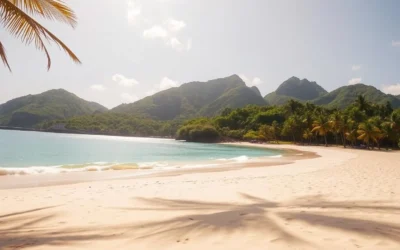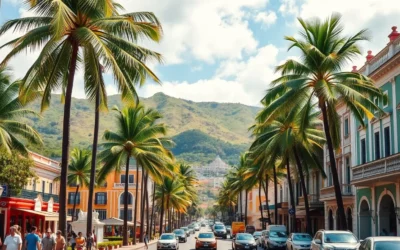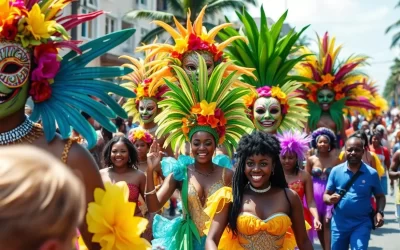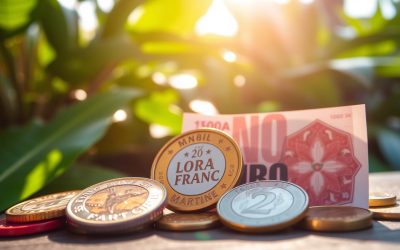✓ Accommodations✓ Flights✓ Rental Cars✓ Tours & Activities
Located in the Caribbean, this island is a unique blend of culture and history. As a part of France, it boasts French as its official language. However, the local population also embraces Martinican Creole, a vibrant vernacular that shapes daily life.
With a population of nearly 350,000, the island thrives on its linguistic diversity. While standard French is used in formal settings, Creole adds a local flavor to conversations. This mix reflects the country‘s rich heritage and identity.
Fort-de-France, the capital, is a hub where both languages coexist. Understanding this dual language system offers a deeper appreciation of the island‘s culture. Whether you’re exploring its history or engaging with locals, this linguistic blend is key to experiencing Martinique fully.
Introduction to Martinique’s Linguistic Landscape
Discover an island where languages tell stories of culture and history. The linguistic texture here is a vibrant mix, shaped by centuries of evolution. From formal settings to casual conversations, the language used reflects the island’s rich heritage.
With a population of nearly 350,000, this island thrives on its diversity. The blend of French and Creole is a testament to its unique identity. Over time, these languages have become symbols of resilience and adaptation.
As a territory of France, the island holds a special status within the French Republic. This connection has influenced its linguistic landscape, making French the official language. Yet, Creole remains deeply rooted in daily life, showcasing the island’s dual nature.
“Language is the roadmap of a culture. It tells you where its people came from and where they are going.”
Understanding this linguistic blend offers a deeper appreciation of the island’s culture. Whether you’re exploring its history or engaging with locals, the coexistence of languages is key to experiencing its essence fully.
Historical Evolution of Languages in Martinique
The linguistic history of this Caribbean gem is deeply tied to its colonial past. Over the centuries, the island has seen waves of cultural influence that shaped its language landscape. From the arrival of French settlers to the interactions with Indigenous people and enslaved Africans, each part of history left its mark.
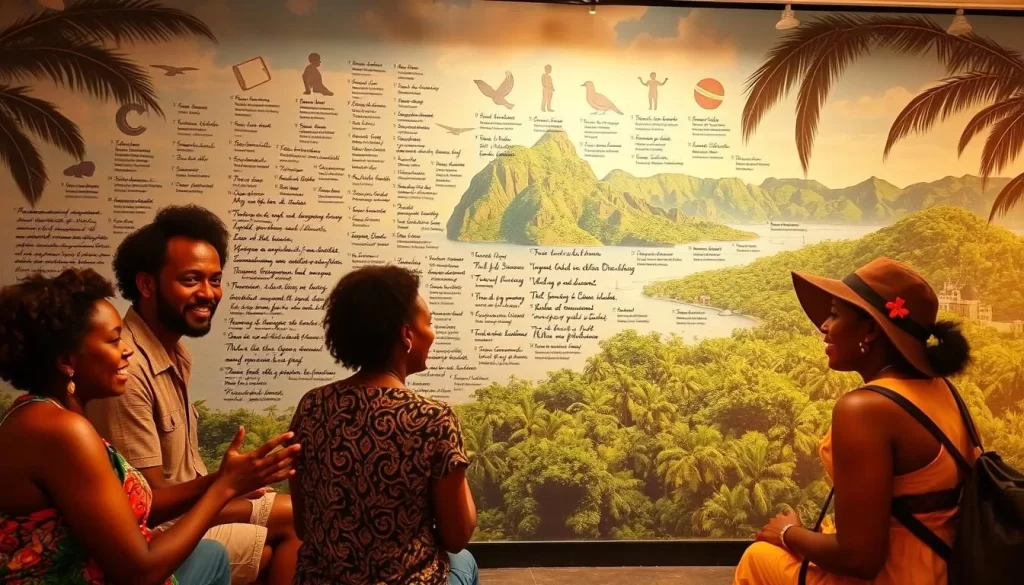
Colonial Influence and Language Shifts
In 1635, French colonization began, marking a turning point for the island. The French settlers brought their language, which became dominant in formal settings. However, the enslaved African population played a crucial role in shaping a new vernacular—Martinican Creole. This blend of French, African, and Indigenous elements created a unique linguistic identity.
By the 18th century, Creole had become a vital means of communication. It allowed enslaved people to connect across cultural divides. This period also saw the rise of key persons who preserved and promoted Creole, ensuring its survival despite colonial pressures.
Post-Colonial Developments
After the abolition of slavery in 1848, the island underwent significant changes. The former slaves faced challenges, but their cultural resilience kept Creole alive. In the 20th century, Martinique became a French department, further solidifying French as the official language.
However, Creole remained a cornerstone of daily life. Today, it is taught in schools and celebrated in media, reflecting its enduring importance. The year 2010 marked another milestone with increased local autonomy, fostering pride in the island’s linguistic heritage.
“Language is not just a tool for communication; it’s a bridge to understanding a culture’s soul.”
This historical journey shows how the island’s languages have always been a part of its broader cultural evolution. From colonial struggles to modern triumphs, the story of language here is one of resilience and adaptation.
Official Language: French
French stands as the backbone of communication on this Caribbean island. As the sole official language, it plays a central role in governance, education, and media. This reflects the island’s status as a French territory, deeply connected to its colonial past.
Legally, French is the language of administration and law. Schools teach in standard French, ensuring fluency across the population. Over time, this has solidified its position as the primary means of formal communication.
Historically, French colonial rule shaped the island’s linguistic identity. While the local vernacular thrives, French remains dominant in official settings. This duality highlights the island’s unique cultural blend.
In everyday life, French is widely used in media, government, and education. It bridges the gap between the island and mainland France, reinforcing its country ties. Whether in newspapers or classrooms, French is ever-present.
“Language is the mirror of a society, reflecting its history and values.”
Examples abound in cultural expression. From literature to official documents, French is the medium of choice. This ensures the island’s integration into the broader Francophone world while preserving its local identity.
Martinican Creole: The Vernacular Voice
Step into the vibrant heart of the Caribbean, where language tells a story of resilience and culture. Martinican Creole is the soul of this island, a vernacular that reflects its rich heritage. It’s more than just words—it’s a way of life.
Creole is deeply rooted in the population, used in everyday conversations and informal settings. While French dominates formal spaces, Creole thrives in homes, markets, and even near the beach. This duality showcases the island’s unique identity.
Over the years, Creole has become a symbol of cultural pride. It blends French, African, and Indigenous influences, creating a language that’s both familiar and distinct. This mix is a testament to the island’s history of adaptation and survival.
In informal settings, Creole is the preferred choice. It’s heard in music, seen in art, and felt in social practices. From traditional dances to local festivals, Creole is an integral part of the island’s cultural expression.
“Creole is the heartbeat of our culture—it connects us to our past and guides us into the future.”
Here’s a quick comparison of how Creole and French are used:
| Aspect | Creole | French |
|---|---|---|
| Usage | Informal, daily conversations | Formal, official settings |
| Cultural Role | Music, art, social practices | Education, governance, media |
| Influence | Local heritage and identity | Connection to mainland France |
Whether you’re exploring the island’s history or chatting with locals, Creole offers a window into its vibrant culture. It’s a language that speaks to the heart of the island and its people.
Cultural Impact of Language on Daily Life
Language shapes the rhythm of daily life on this vibrant island. It’s more than just a way to communicate—it’s a bridge that connects people, traditions, and emotions. Whether in casual chats or formal gatherings, the words you hear reflect the island’s unique identity.
Social Interactions and Community Life
On this island, language is the glue that binds the population together. In markets, homes, and public spaces, you’ll hear a mix of French and Creole. This duality fosters a sense of belonging and inclusivity. For example, during local festivals, people switch between languages effortlessly, celebrating their shared heritage.
Language also plays a role in social status. While French is often used in formal settings, Creole is the heart of informal conversations. This balance allows every person to express themselves authentically, regardless of their background.
Art, Media, and Cultural Expression
The island’s artistic scene is deeply influenced by its linguistic diversity. Music, literature, and visual arts often blend French and Creole, creating a unique cultural tapestry. Zouk, a popular music genre, is a perfect example. Its lyrics and rhythms reflect the island’s history and emotions.
Media outlets also play a key role in shaping cultural identity. Local radio stations and newspapers use both languages, ensuring everyone feels represented. Over time, this has strengthened the bond between the territory and its people.
“Language is the soul of our culture—it’s how we tell our stories and share our dreams.”
From Carnival celebrations to jazz festivals, language is at the heart of every event. It’s not just about words; it’s about preserving a way of life that’s as vibrant as the island itself.
Geography and Demographics Influences on Language
The unique geography of this Caribbean destination plays a key role in shaping its linguistic diversity. The island‘s mountainous terrain and tropical climate create distinct zones where language practices vary. For example, coastal areas often blend French and Creole, while rural highlands preserve traditional Creole dialects.
Demographics also influence how language is used. Nearly 90% of the population lives in urban areas like Fort-de-France, where French dominates. In contrast, rural communities rely more on Creole, reflecting their cultural roots. This divide highlights how geography and population density shape communication.
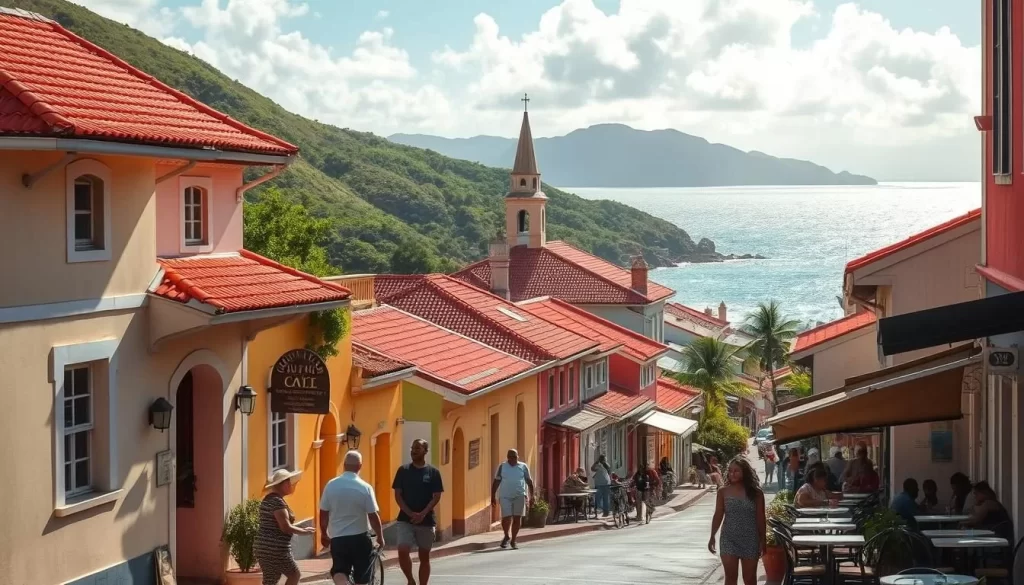
Over the years, migration patterns have further impacted linguistic practices. For instance, the influx of workers in the 19th century introduced new dialects, enriching the island‘s linguistic tapestry. Today, these influences are evident in the way communities interact.
Natural boundaries, such as mountains and rivers, also create distinct language zones. These physical features often isolate communities, leading to unique dialects. Despite these differences, language serves as a bridge, connecting people across the island.
Here’s a breakdown of how geography and demographics shape language usage:
| Region | Primary Language | Influence |
|---|---|---|
| Urban Areas | French | High population density, formal settings |
| Rural Highlands | Creole | Traditional practices, isolation |
| Coastal Zones | French & Creole | Tourism, mixed communities |
Understanding these dynamics offers a deeper appreciation of how language evolves. Whether in bustling cities or quiet villages, the island‘s linguistic diversity reflects its rich heritage. For more insights into Martinique’s population, explore this detailed resource.
Tourism and Language on the Island
Visitors to this island are greeted by a unique blend of languages that reflect its rich culture. As a top tourist destination, the interplay of French and Creole shapes the experience for travelers. Whether you’re strolling along the beach or exploring local markets, you’ll hear both languages in action.
Tourism has a significant impact on linguistic trends here. The influx of international visitors brings new influences while reinforcing the status of local languages. French remains the official language, used in signage and tourist information. Meanwhile, Creole adds a personal touch to interactions, making visitors feel welcome.
Popular tourist areas, like Fort-de-France and the coastal zones, showcase this linguistic blend. These regions attract a diverse population, creating a vibrant atmosphere. Over time, tourism has helped preserve Creole while promoting French as a bridge to the wider world.
Here’s how tourism influences language usage on the island:
| Aspect | Impact |
|---|---|
| Signage & Information | French dominates, ensuring clarity for visitors |
| Daily Interactions | Creole adds authenticity and warmth |
| Cultural Appeal | Language diversity attracts international tourists |
Territorial policies also play a role in maintaining this balance. By promoting both languages, the country ensures that tourism supports cultural preservation. This approach creates a welcoming environment for visitors while honoring the island’s heritage.
Whether you’re enjoying the scenic beaches or exploring historic sites, the linguistic diversity here enhances your experience. It’s a testament to the island’s ability to blend tradition with modern tourism practices.
Governance and Educational Policies Shaping Language
The governance and education systems on this Caribbean island play a pivotal role in shaping its linguistic identity. From state-level policies to local initiatives, the interplay between authority and community ensures a balanced approach to language preservation and promotion.
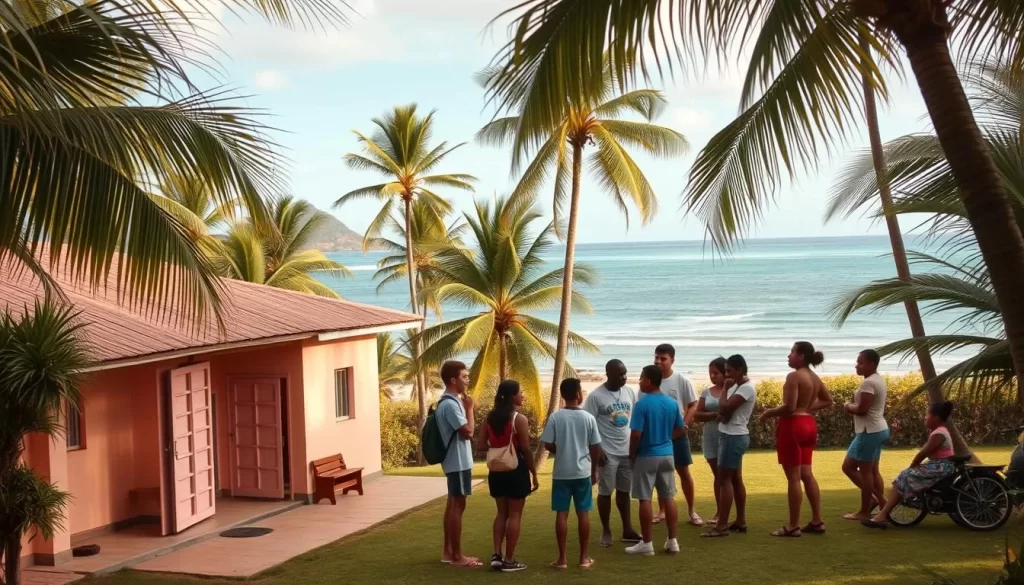
Language Policy Overview
French remains the official language, used in governance, education, and public administration. However, local authorities have made strides in recognizing Creole as a vital part of cultural heritage. Policies enacted in recent years aim to integrate Creole into schools and media, fostering pride among the population.
For example, in 2010, a significant policy shift allowed Creole to be taught in schools. This move aimed to bridge the gap between formal education and everyday life, ensuring that younger generations remain connected to their roots.
The Role of State and Local Authorities
State and local authorities work together to balance the use of French and Creole. While French dominates official settings, Creole thrives in informal spaces. This duality reflects the island‘s unique identity and ensures that both languages coexist harmoniously.
Local initiatives, such as cultural festivals and community programs, play a crucial role in preserving Creole. These efforts highlight the importance of language in shaping community life and fostering a sense of belonging.
| Aspect | French | Creole |
|---|---|---|
| Policy Focus | Official governance and education | Cultural preservation and community programs |
| Usage | Formal settings, legal documents | Informal conversations, local media |
| Impact | Integration with mainland France | Strengthening local identity |
By understanding these policies, you gain insight into how the island balances tradition with modernity. Whether in classrooms or government offices, the linguistic landscape here is a testament to resilience and adaptability.
Martinique: Official and widely spoken languages
The linguistic identity of this Caribbean gem is a blend of tradition and modernity. French, as the official language, dominates formal settings, while Creole thrives in everyday life. This duality reflects the island’s rich cultural tapestry and historical resilience.
Over time, historical, geographical, and administrative factors have shaped this unique language landscape. The population of nearly 350,000 embraces both languages, creating a harmonious balance. Fort-de-France, the capital, serves as a hub where this linguistic blend is most evident.
Key persons and government policies have played a crucial role in regulating language status. For example, in 2010, Creole was introduced into schools, ensuring its preservation for future generations. This move highlights the island’s commitment to maintaining its territorial identity.
Here’s a quick comparison of how French and Creole are used:
- French: Official governance, education, and media.
- Creole: Informal conversations, music, and cultural expression.
“Language is the soul of a culture—it tells the story of its people.”
Understanding this dual language system offers a deeper appreciation of the island’s heritage. Whether you’re exploring Fort-de-France or engaging with locals, the coexistence of languages is key to experiencing its essence fully.
Future Prospects of Linguistic Diversity in Martinique
Looking ahead, the linguistic future of this vibrant destination holds exciting possibilities. The blend of French and Creole will continue to evolve, shaped by education, tourism, and community initiatives. Over the next years, innovative measures are expected to strengthen this unique duality.
Educational policies are playing a key role in shaping the future. Teaching Creole from kindergarten ensures younger generations stay connected to their roots. At the same time, French remains essential for formal communication, creating a balanced approach.
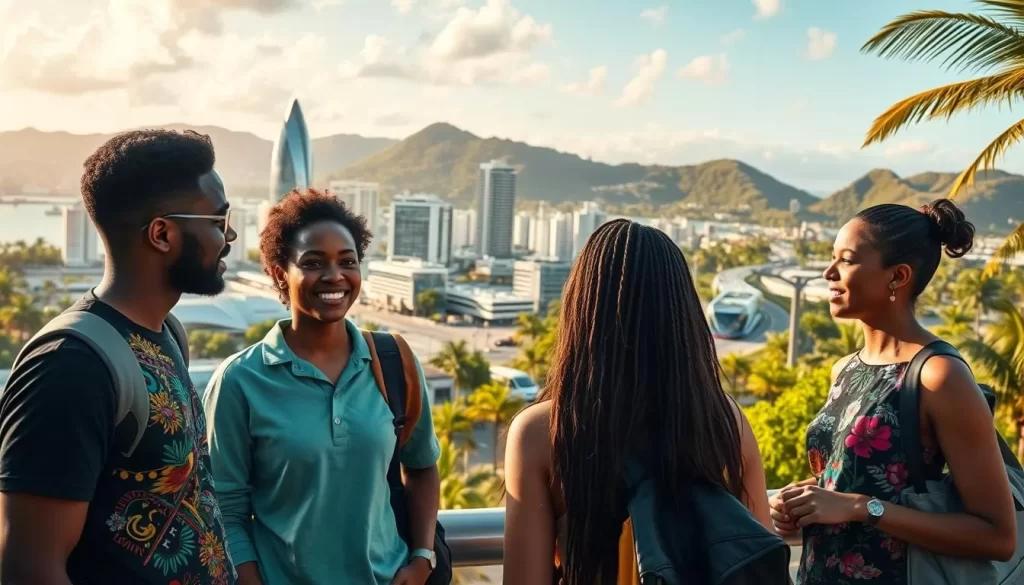
Social interactions among persons are also influencing language use. As communities grow more interconnected, the way people communicate is becoming more fluid. This trend is especially noticeable in popular beach communities, where tourism inspires new expressions.
Here’s a glimpse of how language practices might evolve:
| Factor | Impact |
|---|---|
| Education | Creole integrated into schools, French remains dominant |
| Tourism | Blend of languages in tourist hotspots |
| Community Programs | Cultural festivals and media promoting Creole |
Strategic planning and policy will be crucial in maintaining this balance. By preserving cultural heritage while embracing modern trends, the island ensures its linguistic identity remains vibrant. This approach fosters pride and inclusivity among its people.
“Language is the bridge between our past and our future—it connects us to who we are and who we can become.”
As you explore this destination, you’ll witness how its languages continue to adapt and thrive. Whether in classrooms, markets, or near the beach, the linguistic diversity here is a testament to resilience and innovation.
Conclusion
The linguistic blend of this Caribbean destination reflects its rich cultural heritage. French, as the official language, dominates formal settings, while Creole thrives in daily life. This duality showcases the island’s unique identity and historical resilience.
Over time, governance, geography, and community initiatives have shaped this vibrant linguistic landscape. The year 2010 marked a significant shift, with Creole being integrated into schools, ensuring its preservation for future generations. This balance highlights the country’s commitment to cultural pride.
Language here is more than communication—it’s a bridge to understanding the island’s soul. Whether in formal settings or casual conversations, it plays a vital role in shaping community status and identity. Each person contributes to this living tapestry, ensuring its survival.
Explore this destination to experience its linguistic diversity firsthand. From historic sites to vibrant markets, the blend of French and Creole offers a window into its culture. Preserving this heritage is essential, as it connects the past to the future, enriching every aspect of daily life.
The above is subject to change.
Check back often to TRAVEL.COM for the latest travel tips and deals.


